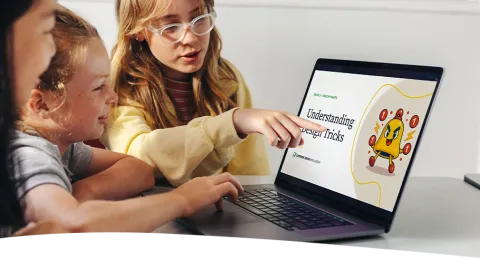
Digital Citizenship Week is October 20–24!
Join teachers worldwide to promote a healthy, positive approach to media and tech.
Take a look inside 5 images
Shake-a-Phrase: Fun with Words and Sentences
Pros: Three modes of play, multiple themes, and custom quiz settings meet a variety of students' needs.
Cons: Some randomly generated sentences don't make sense and incorrect choices are not shown the correct answers.
Bottom Line: Silly sentences and the ability to physically shake the app add a little bit of excitement to grammar, vocabulary, and creative writing instruction.
Teachers can use Shake-a-Phrase in multiple ways. The Shake It! mode generates silly, random sentences where students can tap on words for definitions. Story starters may provide inspiration for individual students during creative writing time or to start off stories written by the whole the class. Quiz Me mode may serve as an entertaining bell-ringer activity or a way to fill both individual and whole-class downtime. The Shake-a-Phrase website also shares how other teachers use the app in the classroom and includes silly stories written and illustrated by students in response to the story starters.
Shake-a-Phrase: Fun with Words and Sentences is a fun grammar and writing app with bright backgrounds, silly sound effects, and three modes of play. Select Shake It! mode and receive a randomly generated silly sentence such as "A surprised donkey crashed into, then ate, a misunderstood knight." Sentences vary by theme, so kids who choose the fairytale theme will see sentences about knights, dragons, and princesses locked in towers. Other themes include sports, monsters, animals, and a general "shake starter set."
In Story Starter mode, the silly sentences become creative writing prompts, and in Quiz Me mode, students must identify specific parts of speech as they appear in the sentences. As they play, kids can "fave" the sentences they like or simply shake the device to see a new sentence, which adds an additional element of fun.
While the sentences found in the three modes of Shake-a-Phrase don't always make sense, they're full of descriptive adjectives and action verbs. This helps expose students to more complex sentences and encourages them to move beyond simple sentences in their own writing. In quiz mode, students are asked to tap various parts of speech and earn trophies, but if they tap an incorrect word the app does not tell the student what part of speech it is, which would be helpful. It would also be nice to see the reasoning behind why each word is the correct vs. incorrect part of speech.
After using the app, students may be more inclined to abandon simple sentences, such as "The zookeeper drew a picture of a pig," in favor of more descriptive sentences like "An enthusiastic and careless zookeeper sketched the juvenile pig." Students can also learn about the words that make up sentences; by clicking on words within a sentence, kids can see definitions and learn where the individual parts of speech typically appear.














